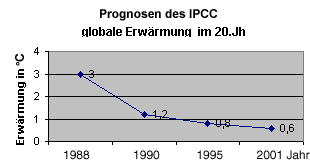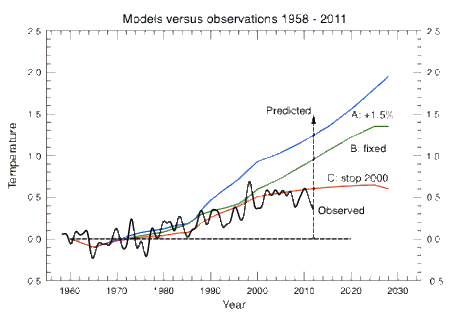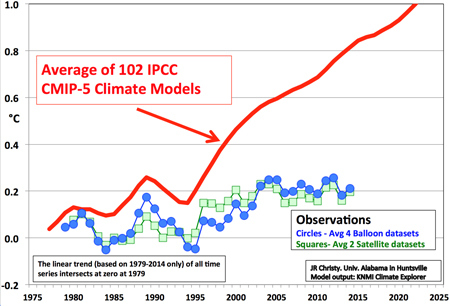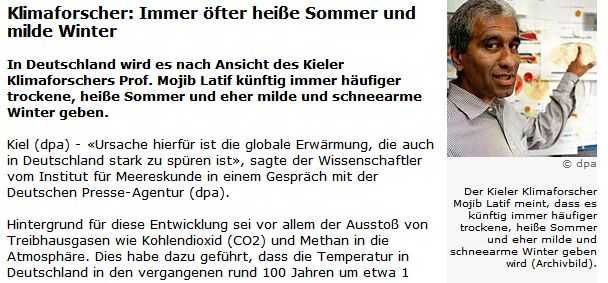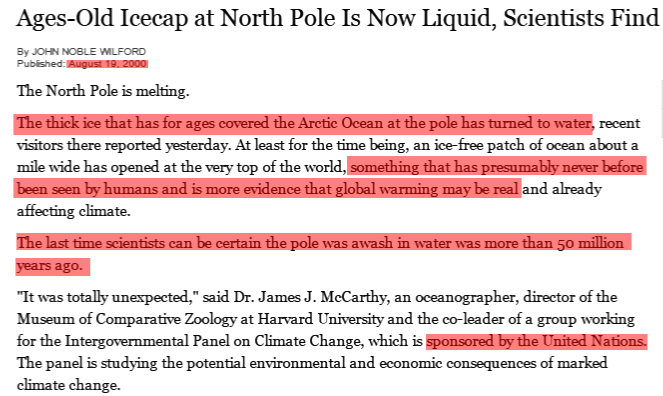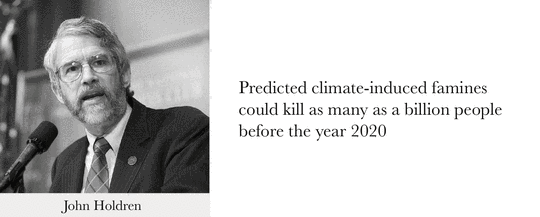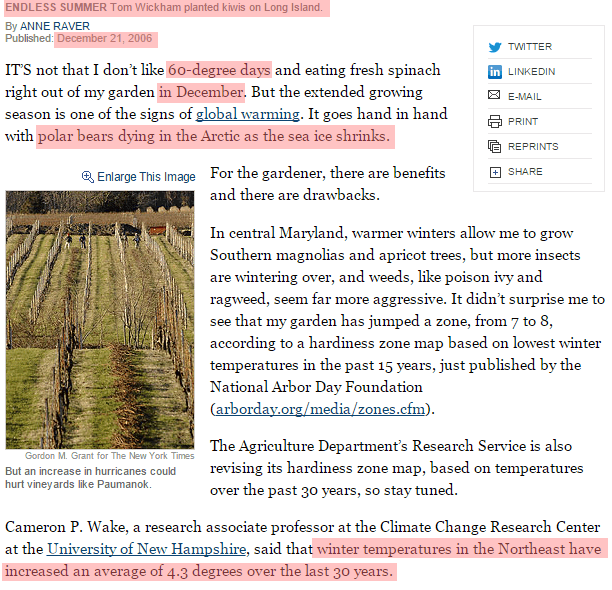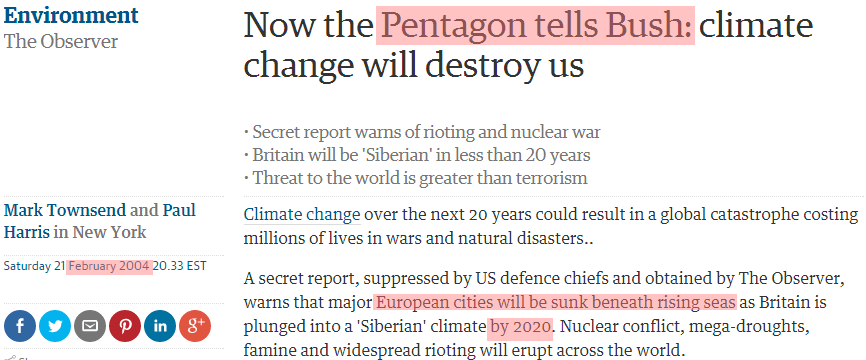3.5.10 Prognosen
en Predictions
fr Prédictions
| ⇧ Probleme / Problems / Problèmes | |||||
| ⇨ | Klimaschwindel | Klima-Panik | UNEP/UNFCCC | IPCC/GIEC | Fehler I |
|---|---|---|---|---|---|
| Fehler II | Kritik | Klima-Modelle | Prognosen | Manipulation | |
| ⇨ | Klima: Wandel│ Fragen│ Wissenschaft│ Probleme│ Beurteilung│ Diskurse│ Auswirkungen | |||
| ⇩ | Klima-Skandal: Manipulation│ Realität│ Angst | |||
| ⇩ | Neue Kälteperiode: Kaltzeit│ Auswirkung | |||
Mit folgenden Links wird von anderen Webseiten auf diese Seite verwiesen:
| de | en | fr |
|---|---|---|
|
Klimawandel: Probleme Prognosen |
Climate change: Problems Prognostics |
Climat: Problèmes Pronostiques |
Links zur Klimaschau
|
|
▶Prognosen ▶Voraussagen einer neuen Kälteperiode |
|
|
▶Prognosen |
|
|
▶Prognosen |
|
|
▶Prognosen |
|
|
▶Klima-Kipppunkte ►Klima-Modelle ▶Prognosen |
|
|
►Klima-Modelle ▶Prognosen |
|
|
▶Energiewende ►Klima-Modelle ▶Prognosen |
- Verzeichnis │ Welt-Info │ Allgemein │ Text
⇧ de Verzeichnis en Contents fr Sommaire
- B de
Fehlprognosen von Umweltaktivisten
en Failed Environmentalist Predictions
fr Prédictions éronnées
- 1 de
Sieben grandiose Fehlprognosen von Umweltaktivisten
en Seven Big Failed Environmentalist Predictions - 2 de
25 Jahre Vorhersage eines 'Kipp-Punktes' bzgl. der globalen Erwärmung
en 25 Years Of Predicting The Global Warming 'Tipping Point' - 3 de
Einige grandios gescheiterte Klima-Prophezeiungen
en Some Failed Climate Predictions
- C de
Falsche Prognosen mit den Computer-Modellen
en Wrong prognostics with computer models
fr Fausses pronostiques avec les modèles d'ordinateurs
- 1 en Climate forecasts have serious methodological errors
- 2 en The big list of failed climate predictions
- 3 en The Greenhouse Gamble
- 1 de
IPCC im Jahr 2007: "Es bleiben vielleicht nur noch acht Jahre bis zur
Klimakatastrophe"
en UN scientists warn time is running out to tackle global warming - 2 de Panik-Angaben des IPCC werden immer kleiner
- 3 de
Falsche Prognosen des IPCC - Das CO2 steigt und die Temperaturen fallen
en CO2 is rising and the temperatures are falling
fr Le CO2 monte et les températures baissent
- 1 de
Was ist eigentlich aus James Hansens Temperaturvorhersagen geworden?
en James Hansen's climate forecasts of 1988: a whopping 150% wrong - 2 Prognosen von Professor Graßl
- 3 Prognosen des Potsdam Institut für Klimafolgenforschung (PIK)
- 4 Prognosen von Professor Latif
- 5 Prognosen von UK Met Office
- 6 15 Years Since The UN Declared The North Pole To Be Ice-Free
- 7 Gore: Polar ice cap may disappear by summer 2014
- 8 John Holdren - Obamas Wissenschaftsberater
- 9 Weitere Prognosen
- F de
Keine wissenschaftlich fundierten Vorhersagen der Globalen
Erwärmung
en No Scientific Forecasts to Support Global Warming
fr Pas de prognostiques scientifiques pour le réchauffement climatique
- 1 de Zweifelhafte wissenschaftliche Methoden bei Klima-Voraussagen
- 2 en No Scientific Forecasts to Support Global Warming
⇧ Welt-Info
|
|
Prognosen / Predictions / Prédictions | |||||||||||
| ▷Die Kalte Sonne Blog‑Themen Vahrenholt/Lüning ▶Die kalte Sonne | de ▷Modelle und Vorhersagen | |||||||||||
| EIKE | de Suchergebnisse für Prognosen, Suchergebnisse für Szenarien | |||||||||||
|
Wikipedia
▶Manipulation von Wikipedia |
|
|||||||||||
| Vademecum |
▶Prognosen
▶Welt-Info |
|||||||||||
| Siehe auch: | ►Klima-Modelle |
⇧ de Allgemein en General fr Générale
-
Wikipedia
de
Prognose
en Prediction
fr Prédiction dynamique
| de | en | fr |
|---|---|---|
|
Neue Kälteperiode Kaltzeit |
New Cold Period Cold Period |
Nouvelle periode froide Periode froide |
| Voraussagen | Predictions | Prédictions |
| Kälte: Warnungen | Cooling: Warnings | Refroidissement: Avertissements |
| Erwärmung: Entwarnung | Warming: All-Clear | Réchauffement: Fin de l'alerte |
| Eiszeiten | Ice Ages | Glaciations |
| de | en | fr |
|---|---|---|
|
Klima Geschichte Klima in der Zukunft |
Climate History Climate in the future |
Histoire du climat Climat dans le futur |
| de | en | fr |
|---|---|---|
| Neuste Informationen über den Klimawandel | News on Climate Change | Nouvelles informations sur le changement climatique |
| Die Erwärmungspause | The Hiatus | La pause du réchauffement climatique |
| de | en | fr |
|---|---|---|
|
Neue Kälteperiode Forschungsergebnisse und Hypothesen |
New Cold Period Research and Hypotheses |
Nouvelle periode froide Recherches et hypothèses |
| de | en | fr |
|---|---|---|
| Klimawandel: Diskussionen | Climate change: Discussions | Changement climatique: Discussions |
| Hiobs-Prognosen | ||
| de | en | fr |
|---|---|---|
|
Argumente Klimamodelle und Prognosen der Warmisten |
Arguments Wrong Climate Models and and wrong forecasts |
Arguments Modèles climatiques et prévisions éronnés |
| de | en | fr |
|---|---|---|
|
Klimawandel: Probleme Klima-Modelle |
Climate change: Problems Climate Models |
Climat: Problèmes Modèles climatiques |
| de | en | fr |
|---|---|---|
|
Klimawandel: Probleme Prognosen |
Climate change: Problems Prognostics |
Climat: Problèmes Pronostiques |
| de | en | fr |
|---|---|---|
| Klima Berichte | Climate Reports | Rapports sur le climat |
| Falsche Prognosen der Paniker 2007 | Wrong prognostics 2007 | Fausses prévisions 2007 |
| de | en | fr |
|---|---|---|
|
Klima Skandal: Erwärmung Falschinformationen |
Scandal: Warming Desinformations |
Scandale: Réchauffement Désinformations |
⇧ de Text en Text fr Texte
↑
A Prognosen-Probleme
en Prediction Problems
fr Probèmes avec les prédictions
de Verzeichnis en Contents fr Sommaire
- 2019
- de
Warum Wolken der Fluch aller Klimaforscher sind
Hamburger Max-Planck-Forscher Stevens: "Unsere Computer sagen nicht einmal mit Sicherheit voraus, ob die Gletscher in den Alpen zu- oder abnehmen werden" - de Klimawandel-Modelle sind Ramsch
- 2015
- de Die Problematik der Klima-Prognosen
- de Sieben grandiose Fehlprognosen von Umweltaktivisten
- 2014
- de
 Prognose oder Szenario ?
Prognose oder Szenario ?
de Text en Text fr Texte
⇧ 2019
↑
Warum Wolken der Fluch aller Klimaforscher sind
Hamburger Max-Planck-Forscher Stevens:
"Unsere Computer sagen nicht einmal mit Sicherheit voraus, ob die
Gletscher in den Alpen zu- oder abnehmen werden"
-
Spiegel (Printausgabe) / Johann Grolle
2019-03-22 de Warum Wolken der Fluch aller Klimaforscher sindVorhersagen zur Erderwärmung sind noch immer erstaunlich ungenau.
Supercomputer und künstliche Intelligenz sollen helfen.
Die Klimasensitivität
Es ist eine schlichte Zahl, doch wird sie das Schicksal dieses Planeten bestimmen.
Sie ist leicht zu beschreiben, doch vertrackt schwierig zu berechnen.
Die Forscher nennen sie: "Klimasensitivität".
Sie gibt an, um wie viel sich die Durchschnittstemperatur auf der Erde erwärmt, wenn sich die Konzentration der Treibhausgase in der Atmosphäre verdoppelt.
Schon in den Siebzigerjahren wurde sie mithilfe primitiver Computermodelle ermittelt.
Die Forscher kamen zu dem Schluss, dass ihr Wert vermutlich irgendwo zwischen 1,5 und 4,5 Grad liegen dürfte.
An diesem Ergebnis hat sich bis heute, rund 40 Jahre später, nichts geändert.
Und genau darin liegt das Problem.
Die Rechenleistung der Computer ist auf das Vielmillionenfache gestiegen, aber die Vorhersage der globalen Erwärmung ist so unpräzise wie eh und je.
"Es ist zutiefst frustrierend", sagt Bjorn Stevens vom Hamburger Max-Planck-Institut für Meteorologie.
Seit mehr als 20 Jahren forscht er nun schon auf dem Feld der Klimamodellierung.
Kommentar und weitere Auszüge:
-
Die kalte Sonne (Fritz Vahrenholt & Sebastian Lüning)
2019-03-30 de Hamburger Max-Planck-Forscher Stevens:
"Unsere Computer sagen nicht einmal mit Sicherheit voraus, ob die Gletscher in den Alpen zu- oder abnehmen werden"Die Klimamodelle stehen weiter in der Kritik.
Sie haben weder die Abbremsung der Erwärmung zu Beginn der Jahrtausendwende kommen sehen,
noch gelingt es ihnen, die Temperaturentwicklung der letzten Jahrtausende zu reproduzieren.
Die Print-Ausgabe des Spiegel brachte am 22. März 2019 einen ausgezeichneten Beitrag über die Probleme der Klimamodelle.
Der Artikel von Johann Grolle ist leider nur für Abonnenten zugänglich, aber er ist es wert, den Gratismonat zu aktivieren bzw. das Heft zu bestellen.
Hier einige Auszüge:
Warum die Vorhersagen zur Erderwärmung so schwierig sind
Vorhersagen zur globalen Erwärmung sind noch immer erstaunlich ungenau. Supercomputer und künstliche Intelligenz sollen helfen.
Zur Klimasensitivität
Schon in den Siebzigerjahren wurde [die Klimasensitivität] mithilfe primitiver Computermodelle ermittelt.
Die Forscher kamen zu dem Schluss, dass ihr Wert vermutlich irgendwo zwischen 1,5 und 4,5 Grad liegen dürfte.
An diesem Ergebnis hat sich bis heute, rund 40 Jahre später, nichts geändert.
Und genau darin liegt das Problem.
Die Rechenleistung der Computer ist auf das Vielmillionenfache gestiegen, aber die Vorhersage der globalen Erwärmung ist so unpräzise wie eh und je.
"Es ist zutiefst frustrierend", sagt Bjorn Stevens vom Hamburger Max-Planck-Institut für Meteorologie.
Stevens hat selbst viel beigetragen zum Fortschritt. Und doch musste er sich immer wieder aufs Neue eingestehen, dass seine Zunft, was die Vorhersage des Klimawandels betrifft, auf der Stelle tritt.
Um sich jedoch konkret auf das Kommende vorzubereiten, taugten die Modelle der Klimaforscher nicht.
Als Entscheidungshilfe beim Bau von Deichen und Entwässerungskanälen seien sie ungeeignet.
"Unsere Computer sagen nicht einmal mit Sicherheit voraus, ob die Gletscher in den Alpen zu- oder abnehmen werden", erklärt Stevens.
Die Schwierigkeiten, denen sich er und seine Forscherkollegen gegenübersehen, lassen sich in ein Wort fassen:
Wolken.
Die träge über den Himmel ziehenden Gebirge aus Wasserdampf
sind der Fluch aller Klimaforscher.
Die Forscher können in ihren Modellen das Wasser nicht verdunsten, aufsteigen und kondensieren lassen, so wie es dies in der Wirklichkeit tut.
Sie müssen sich mit mehr oder weniger plausiblen Faustregeln behelfen.
"Parametrisierung" heißt das Verfahren, doch die Forscher wissen:
In Wirklichkeit ist das der Name einer chronischen Krankheit, von der all ihre Klimamodelle befallen sind.
Oft liefern sie drastisch voneinander abweichende Ergebnisse.
Die Temperaturen in der Arktis zum Beispiel klaffen in den verschiedenen Modellen um teilweise mehr als zehn Grad auseinander.
Das lässt jede Prognose der Eisbedeckung wie bloße Kaffeesatzleserei erscheinen.
Einstweilen allerdings ist nur gewiss, dass die Menschheit noch einige Zeit auf handfestere Klimaprognosen wird warten müssen.
Und selbst wenn sich die Wolken irgendwann den Gleichungen der Forscher fügen,
wird die Welt dann sicher vor Überraschungen sein?
Keiner der beiden Forscher mag da Entwarnung geben.
"Wir betreten unkartiertes Terrain", sagt Schneider.
"Da gibt es keine Gewissheiten."
|
|
↑ Klimawandel-Modelle sind Ramsch
-
EIKE Europäisches Institut für Klima und Energie
Michael Klein, Dipl-Soz, Sciencefiles
2019-03-17 de Klimawandel-Modelle sind RamschDie Hysterie um Kohlendioxid und der unmittelbar bevorstehende Untergang der Erde, den manche besonders hysterische Hysteriker an die Wand malen und insbesondere die Versuche der politischen Klasse, die entsprechende Hysterie zu befeuern und politisch auszunutzen, hat uns veranlasst, uns etwas intensiver mit der wissenschaftlichen, nein: der angeblich wissenschaftlichen Seite des Klimawandels zu beschäftigen.
Gestern haben wir einen Beitrag veröffentlicht, in dem wir Zweifel an der Rolle von CO2 im Gesamtmodell des Klimawandels und Global Warmings anmelden.
Heute wollen wir einen genaueren Blick auf die entsprechenden Modelle richten, die sich der Vorhersage des Klimawandels widmen, zunächst noch nicht aus mathematischer Sicht.
Modelle, die etwas vorhersagen sollen, basieren auf einer Vielzahl von Annahmen über Zusammenhänge.
Diese Annahmen können entweder auf Basis von vergangenen Beobachtungen aufgestellt werden.
Oder sie können das Ergebnis dessen sein, was Wissenschaftler gemeinhin "Tuning" nennen, das Anpassen eines eigenen Modells, so dass das berechnete Ergebnis aktuellen Daten entspricht.
Mit diesem Tuning verbindet sich dann die Hoffnung, wir würden sagen: der induktive Fehlschluss, dass auf der Grundlage des so formulierten Modells auch die Zukunft berechnet werden kann.
Damit sind wir bei den Modellen angekommen, die die Zukunft der Erde berechnen wollen, die angeblich in der Lage sind, die Erwärmung der Erde auf das zehntel Grad Celsius genau zu berechnen und den höheren Wasserstand der Meere auf zwei Stellen hinter dem Komma genau.
⇧ 2015
↑ Die Problematik der Klima-Prognosen
-
EIKE Europäisches Institut für Klima und Energie
Peter Schoeck
2015-07-15 de Die Problematik der Klima-PrognosenAufgrund der von dem serbischen Mathematiker Milankovic 1941 angestellten Berechnungen können wir heute die periodische Veränderung des Klimas über Zeiträume von hundert Millionen Jahren "deuten".
↑ Sieben grandiose Fehlprognosen von Umweltaktivisten
-
EIKE Europäisches Institut für Klima und Energie
Robert Tracinski
2015-05-06 de Sieben grandiose Fehlprognosen von UmweltaktivistenVor kurzem habe ich diskutiert, was erforderlich wäre, um zu beweisen, dass die globale Erwärmung tatsächlich stattfindet, dass sie vom Menschen verursacht ist und dass sie katastrophal werden wird.
Aber das ist nicht das vollständige Bild.
Um zu verstehen, warum so viele von uns skeptisch sind hinsichtlich der globalen Erwärmung, muss man umfassend auf die Äußerungen der Umweltaktivisten schauen:
sie bestehen aus einer langen Reihe von Fehlvorhersagen und betrügerischen Untergangs-Prophezeiungen.
⇧ 2014
↑ Prognose oder Szenario ?
-
Klima Manifest Heiligenroth
2014-11-23 de Prognose oder Szenario ?
Prognose oder Szenario ?
↑
B Fehlprognosen von Umweltaktivisten
en Failed Environmentalist Predictions
en Prédictions éronnées
- 1 de
Sieben grandiose Fehlprognosen von Umweltaktivisten
en Seven Big Failed Environmentalist Predictions - 2 de
25 Jahre Vorhersage eines 'Kipp-Punktes' bzgl. der globalen Erwärmung
en 25 Years Of Predicting The Global Warming 'Tipping Point' - 3 de
Einige grandios gescheiterte Klima-Prophezeiungen
en Some Failed Climate Predictions
↑
1 Sieben grandiose Fehlprognosen von Umweltaktivistenn
en Seven Big Failed Environmentalist Predictions
-
EIKE Europäisches Institut für Klima und Energie
2015-05-06 de Sieben grandiose Fehlprognosen von Umweltaktivisten
-
The Global Warming Policy Forum (GWPF)
2015-04-25 en Seven Big Failed Environmentalist Predictions
Quelle / Source:
-
The Federalist
en Seven Big Failed Environmentalist Predictions
↑
2 25 Jahre Vorhersage eines 'Kipp-Punktes' bzgl. der globalen Erwärmung
en 25 Years Of Predicting The Global Warming 'Tipping Point'
-
EIKE Europäisches Institut für Klima und Energie
2015-05-10 de 25 Jahre Vorhersage eines 'Kipp-Punktes' bzgl. der globalen Erwärmung
-
Daily Caller
2015-05-04 de 25 Years Of Predicting The Global Warming 'Tipping Point'
| de | en | fr |
|---|---|---|
|
Klima: Fragen Klima-Kipp-Punkte |
Climate: Questions Climate Tipping Points |
Climat: Questions Points de non retour dans le climat |
↑
3 Einige grandios gescheiterte Klima-Prophezeiungen
en
Some Failed Climate Predictions
-
EIKE Europäisches Institut für Klima und Energie
Andy May / Chris Frey
2017-11-88 de Einige grandios gescheiterte Klima-Prophezeiungen
-
Watts UP With That? (Antony Watts)
Javier
2017-10-30 en Some Failed Climate Predictions
↑
C Falsche Prognosen mit den Computer-Modellen
en Big Failed Environmentalist Predictions
- 1 en Climate forecasts have serious methodological errors
- 2 en The big list of failed climate predictions
- 3 en The Greenhouse Gamble
↑ 1 Climate forecasts have serious methodological errors, little connection with reality
-
CFP Canada Free Press
2009-06-04 en Climate forecasts have serious methodological errors, little connection with reality
↑ 2 The big list of failed climate predictions
-
Watts up with that? (Antony Watts)
2014-04-02 en The big list of failed climate predictions
↑ 3 The Greenhouse Gamble
de Aus der Panik-Küche en From the panic laboratory fr De la marmite des alarmistes
![]()
![]()
![]() The Greenhouse Gamble:
The Greenhouse Gamble:
Ronald Prinn, director of MIT's Center for Global Change Science,
and his group have revised their model that shows how much hotter the
Earth's climate will get in this century without substantial policy
change

de
-
Klimaskeptiker.info
2009-05-25 de Pure Panikmache: MIT prognostiziert 7°C Temperaturanstieg bis 2100
"Wenn die Prognose dieser "Wissenschaftler" eines Temperaturanstiegs um 7°C bis 2100 auch mit dieser Methode entstanden ist, wundert mich nichts mehr. Immerhin gestehen diese Alarmisten mit der Einführung des Zufallselements (unbewußt?) zu, daß sie eben keine gesicherte Prognose aufstellen, sondern nur mit unvollständigen Computermodellen herumgespielt haben. Sie haben in Wirklichkeit keine Ahnung, wie sich das Klima künftig entwickeln wird."
en
-
POPSCI Com Popular Science
2009-05-25 en Global Warming: a Controversial Bill, And a Game of Roulette
Comments received: The simple fact is that the source of these dire warnings come from computer "models" written by humans with a vested interest in a warming outcome. These same "models" lack vital information about cloud formation and its associated effects on the earth's temperature. Now who's playing roulette?
-
Whats Up With That? (Anthony Watts)
2009-05-25 en MIT: Global Warming of 7°C 'Could Kill Billions This Century'
"Global warming of 7C 'could kill billions this century'.
Global temperatures could rise by more than 7C this century killing billions of people and leaving the world on the brink of total collapse, according to new research".
2009-05-26 en How not to make a climate photo op
"You have to wonder - what were these guys thinking?"
↑ D Falsche und immer wieder korrigierte Szenarien und Prognosen des IPCC
- 1 de
IPCC im Jahr 2007: "Es bleiben vielleicht nur noch acht Jahre bis zur
Klimakatastrophe"
en UN scientists warn time is running out to tackle global warming - 2 de Panik-Angaben des IPCC werden immer kleiner
- 3 de
Falsche Prognosen des IPCC - Das CO2 steigt und die Temperaturen fallen
en CO2 is rising and the temperatures are falling
fr Le CO2 monte et les températures baissent
↑
1 IPCC im Jahr 2007: "Es bleiben vielleicht nur noch acht Jahre bis zur
Klimakatastrophe"
en
UN scientists warn time is running out to tackle global warming
-
Die kalte Sonne (Fritz Vahrenholt & Sebastian Lüning)
2015-06-02 de IPCC im Jahr 2007: "Es bleiben vielleicht nur noch acht Jahre bis zur Klimakatastrophe"Im Jahr 2007 warnte der IPCC anlässlich der Herausgabe des 4. Klimazustandsberichts, dass die Zeit allmählich knapp werde, um die Klimakatastrophe noch zu vermeiden.
Man hätte vermutlich nur noch 8 Jahre, um der Apokalypse zu entkommen.
Man müsse umgehend handeln, sonst drohe die Hölle auf Erden.
Rechnen wir kurz nach:
2007 plus 8 ergibt 2015, unser heutiges Jahr. Von der Klimakatastrophe ist allerdings immer noch nichts zu sehen.
Die Temperatur liegt heute auf dem gleichen Niveau wie 2007 - und wie 1998.
Auch Wetterextreme haben nicht zugenommen.
Ganz offensichtlich hat man 2007 wohl etwas übertrieben.
Erinnern will sich daran heute niemand mehr.
Man blickt lieber in die Zukunft.
Was geht mich mein Geschätz von gestern an?Gelernt hat man aus der Pleite trotzdem: Mojib Latif
Kurzerhand verdoppelte Mojib Latif jetzt die Zeitspanne auf 15 Jahre und startet die Uhr 2015 einfach wieder neu bei Null.
Genial - Die Welt berichtete am 5. April 2015:
Es bleibt nicht mehr viel Zeit.
Das ist die Botschaft, die Klimaforscher den Politikern auf der ganzen Welt auf den Weg geben.
Nur noch 15 Jahre bleiben nach ihrer Ansicht, um den Klimawandel in den Griff zu bekommen. "Wenn der weltweite Kohlendioxidausstoß 2030 immer noch steigt, wird es zu spät sein", sagt der Klimaforscher Mojib Latif vom Kieler Helmholtz-Zentrum für Ozeanforschung.
Es ist das erste Mal, dass Latif sich öffentlich so konkret festlegt.
Im Jahr 2030 ist Latif dann in Rente und es kann ihm dann herzlich egal sein, ob er richtig oder falsch lag.
Ihm muss dabei bewusst sein, dass die Temperaturen auch in 15 Jahren noch auf dem heutigen Niveau liegen könnten, da die Ozeanzyklen bis dahin kühlend wirken werden.
Siehe "Judith Curry prognostiziert Erwärmungspause bis in die 2030er Jahre:
 Nordatlantik wird sich im kommenden Jahrzehnt leicht abkühlen
Nordatlantik wird sich im kommenden Jahrzehnt leicht abkühlen
Hans von Storch fordert in einem solchen Fall Misstrauensvotum gegen CO2".
▶Hans von Storch fordert in einem solchen Fall Misstrauensvotum gegen CO2
Quellen / Sources:
-
Die Welt
2015-04-05 de 2030 schließt sich das Zeitfenster der ErderwärmungNur noch 15 Jahre bleiben nach ihrer Ansicht, um den Klimawandel in den Griff zu bekommen.
Der Klimawandel ist noch abwendbar.
Das zumindest sagt der Klimawissenschaftler Mojib Latif.
Der sinkende Kohle-Verbrauch in China erscheint ihm als leiser Hoffnungsschimmer.
![]() USA: Kohle und Kohlekraftwerke
USA: Kohle und Kohlekraftwerke
![]() de
Die Vereinigten Staaten sind das "Saudi Arabien" der Kohle
de
Die Vereinigten Staaten sind das "Saudi Arabien" der Kohle
en
America is the "Saudi Arabia" of Coal
fr
Les Étas Unis sont "l'Arabie Saoudite" du charbon
-
The Guardian
2007-05-02 en UN scientists warn time is running out to tackle global warmingGovernments are running out of time to address climate change and to avoid the worst effects of rising temperatures, an influential UN panel warned yesterday.
Greater energy efficiency, renewable electricity sources and new technology to dump carbon dioxide underground can all help to reduce greenhouse gas emissions, the experts said.
But there could be as little as eight years left to avoid a dangerous global average rise of 2C or more.
↑ 2 Panik-Angaben des IPCC werden immer kleiner
-
Seit 1988 sind die Aussagen des IPCC über die Auswirkungen des Global Warming ständig nach unten korrigiert worden.
-
Die Erwärmung im 20. Jahrhundert wurde von 3 °C auf 0,6 °C korrigiert.
-
Der Meeresspiegelanstieg von 20 cm bis 1,5 m auf Ende 2030 wurde auf 5 bis 35 cm und später auf 33 cm bis Ende des Jahrhunderts heruntergesetzt.
(Al Gore gibt 6,1 m an!)
"Anthropogener" Meeresspiegelanstieg - Vom Konstrukt zur Panik?
Die IPCCPrognosen passen sich mehr und mehr der Realität von ca. 20 cm/Jahrhundert an.
![]()
![]()
![]() Abb. 10. Prognosen des IPCC zum Meeresspiegelanstieg im 21. Jahrhundert
Abb. 10. Prognosen des IPCC zum Meeresspiegelanstieg im 21. Jahrhundert

-
EIKE Europäisches Institut für Klima und Energie
2008-12-04 de "Der Spiegel" heizt die Arktis künstlich auf -
EIKE Europäisches Institut für Klima und Energie
Klaus-Eckart Puls, Bad Bederkesa
Naturwissenschaftliche Rundschau | 61. Jahrgang, Heft 11, 2008
de "Anthropogener" Meeresspiegelanstieg - Vom Konstrukt zur Panik?
"Anthropogener" Meeresspiegelanstieg - Vom Konstrukt zur Panik?
Aussage betreffend Anstieg des Meeresspiegels:
- 1990 prognoszitierte der Welt-Klimarat einen Anstieg des Meeresspiegels von von über 60 cm. Einige Jahre später waren es 50 cm und heute spricht der Klimarat von nur noch über 30 cm.
-
ARD München de
 IPCC zensiert Klimawissenschaftler
Klimaschwindel
IPCC zensiert Klimawissenschaftler
Klimaschwindel
Globale Erwärmung
- Wasserplanet: Prognosen des IPCC
Erwärmung und Anstieg der Meere
|
|
|
|
|
|
|
||
|
|
|
|
|
|
|
|
|
|
|
|
|
|
|
- nationalcenter.org: Global Warming Earth Summit Fact Sheet
↑
3 Falsche Prognosen des IPCC:
Das CO2 steigt und die Temperaturen fallen
en CO2 is rising and the temperatures are falling
fr Le CO2 monte et les températures baissent
| de | en | fr |
|---|---|---|
| Das CO2 steigt und die Temperaturen fallen | CO2 is rising and the temperatures are falling | Le CO2 monte et les températures baissent |
↑
E Falsche Prognosen der Warmisten
en Wrong prognostics of the Warmist Gurus
fr Fausses prévisions des gurus réchauffistes
- 1 de
Was ist eigentlich aus James Hansens Temperaturvorhersagen geworden?
en James Hansen's climate forecasts of 1988: a whopping 150% wrong - 2 Prognosen von Professor Graßl
- 3 Prognosen des Potsdam Institut für Klimafolgenforschung (PIK)
- 4 Prognosen von Professor Latif
- 5 Prognosen von UK Met Office
- 6 15 Years Since The UN Declared The North Pole To Be Ice-Free
- 7 Gore: Polar ice cap may disappear by summer 2014
- 8 John Holdren - Obamas Wissenschaftsberater
- 9 Weitere Prognosen
↑
1 Was ist eigentlich aus James Hansens Temperaturvorhersagen geworden?
en James Hansen's climate forecasta of 1988:
a whopping 150% wrong
1986
|
WASHINGTON, June 10 1986
The rise in carbon dioxide and other gases in the earth's atmosphere will have an earlier and more pronounced impact on global temperature and climate than previously expected, according to evidence presented to a Senate subcommittee today.
Scientists and senators at a hearing by the Environmental Pollution Subcommittee agreed that the dangers of manmade changes in the atmosphere had moved from hypothesis to imminent reality and must be addressed quickly.
They said the rise in temperatures was expected to cause profound climatic changes and raise sea levels substantially.
Witnesses at the hearing also testified that the ozone layer of the upper atmosphere, which protects the earth from the sun's ultraviolet light, is being rapidly depleted by manmade gases, and the increased ultraviolet radiation would result in a rise in skin cancer cases and other ecological damage.
Dr. James E. Hansen of the Goddard Space Flight Center's Institute for Space Studies said research by his institute showed that because of the ''greenhouse effect'' that results when gases prevent heat from escaping the earth's atmosphere, global temperatures would rise early in the next century to ''well above any level experienced in the past 100,000 years.'' Steeper Rise in Next Century
Average global temperatures would rise by one-half a degree to one degree Fahrenheit from 1990 to 2000 if current trends are unchanged, according to Dr. Hansen's findings.
Dr. Hansen said the global temperature would rise by another 2 to 4 degrees in the following decade.
While the effect of small increases in global temperature is now unclear, Andrew Maguire, vice president of the World Resources Institute, a Washington research and policy group, said that the doubling of atmospheric carbon dioxide that is foreseen would cause a rise of 3 to 8 degrees in temperature by the 2030's.
He said this would devastate agriculture in the United States and elsewhere, and would cause a rise in sea level of some 4.5 feet as polar ice melted.
Earlier projections of warming trends had held that they would not occur before the middle of the next century.
One of the reasons that scientists now expect faster and higher temperature rises is the emerging consensus that gases other than the carbon dioxide emitted by the burning of such fossil fuels as coal are playing a major role in the greenhouse effect.
The greenhouse effect is the name given to the phenomenon created when carbon dioxide, methane, chlorofluorocarbons and other gases accumulate in the atmosphere and prevent radiant heat from the sun that has reached the earth's surface from escaping back into space.
Dr. Hansen and other scientists testifying today said there was now broad consensus among scientists that the greenhouse effect was speeding up the increase in global temperatures. Less Urgency in 1983
In 1983 a report by the National Academy of Sciences said the greenhouse effect was a ''cause for concern,'' but concluded that there was time to prepare for its impact.
The academy report projected a doubling of greenhouse gases by the third quarter of the next century.
Dr. Hansen's research, however, found that if there is no change in the current rate of growth, the greenhouse gases would double by the late 2020's.
A report by the Environmental Protection Agency three years ago said the warming trend could start by the 1990's and could reach as much as 4 degrees Fahrenheit by 2040, but this was attacked by President Reagan's science adviser at the time, George A. Keyworth, as ''unnecessarily alarmist.''
Today, the scientists and the senators on the subcommittee asserted that there must be national and international action now to mitigate and deal with the imminent effects of the atmospheric changes taking place as a result of human activity. Chafee Asks Early Action
Senator John H. Chafee, the Rhode Island Republican who is chairman of the subcommittee, quoted a recent assessment by the Department of Energy, which said, ''Human effects on atmospheric composition and the size and operations of the terrestrial ecosystems may yet overwhelm the life-support system crafted in nature over billions of years.''
Senator Chafee said it would be too risky to wait until all the answers about atmospheric changes were known before taking action.
He called for the Reagan Administration to take up the issue at the next international economic summit meeting and also at the President's next meeting with the Soviet leader, Mikhail S. Gorbachev. While the scientists testified today that it would be some time before there was enough data to pinpoint regional climatic changes, it was considered likely that some of today's most productive agricultural areas would become too arid for farming.
They also testified that a ''hole,'' in which the ozone has been reduced by some 40 percent, has formed in the ozone layer over Antarctica.
While many aerosol uses of chlorofluorocarbons have been banned in this country, their use in other applications is increasing, and they continue to be used in aerosols in other countries.
1988
|
A
B
C |
||
|
Laut der Hansen-Prognose müsste die Temperatur gegenüber dem Vergleichsniveau in den 1970er Jahren um 1,5°C angestiegen sein. In Wahrheit hat sich die Temperatur jedoch lediglich um 0,6°C erhöht. |
Die CO2-Emissionen sind seit dem Jahr 2000 um jährlich etwa 2,5 Prozent angestiegen, so dass wir gemäß dem Hansen-Paper einen Temperaturanstieg erwarten würden, der stärker als in Modell A ausfallen sollte. |
Es ist ersichtlich, dass die von der Hansen-Gruppe 1988 modellierte Temperaturvorhersage um etwa 150% danebenliegt.
Es ist überaus bedauerlich, dass genau diese Art von Modellierungen von unseren Politikern noch immer als verlässliche Klimavorhersage angesehen wird.
-
Die kalte Sonne (Fritz Vahrenholt & Sebastian Lüning)
Gastbeitrag von Prof. Jan-Erik Solheim (Oslo)
2012-06-15
de Was ist eigentlich aus James Hansens Temperaturvorhersage von 1988 geworden? Zeit für eine Überprüfung
en English original version of the article: James Hansen's predictions versus observations
-
Watts Up With That? (Antony Watts)
2012-06-15 en James Hansen's climate forecast of 1988: a whopping 150% wrong
-
Real Science (Steven Goddard)
2012-06-15 en Clarifying Hansen's Scenarios - Worse Than It Seems
| James (Jim) E. Hansen |
Dr., Former Head of NASA Goddard Institute for Space Studies
in New York City
He also serves as Al Gore's science advisor
▶James (Jim) E. Hansen: Who is who (Aktivisten der anthropogenen Globalen Erwärmung) ▶Ausschluss und Maulkorb für Kritiker (Das renommierte amerikanische Museum für nationale Geschichte (AMNH) in New York Opfer des Klimakriegs) |
← 2 Prognosen von Professor Graßl
-
Die kalte Sonne (Fritz Vahrenholt, Sebastian Lüning)
2012-04-04 de Graßl's Erwärmungsprognose von 1990 droht dramatisch zu scheiternIm Jahre 1990, also vor nunmehr 22 Jahren, alarmierte Hartmut Graßl mit seinem Buch "Wir Klimamacher" die Öffentlichkeit und sagte eine schlimme Klimakatastrophe vorher.
Auf Seite 61 schrieb er damals zusammen mit seinem Co-Autor Reiner Klingholz:
"Schon in den nächsten 30 Jahren wird sich die Erde mit hoher Wahrscheinlichkeit um ein bis zwei Grad erwärmen."
Nun sind die 30 Jahre bald um und wir erlauben uns nachzuschauen, ob sich die Natur an die Prognose gehalten hat.
Das Ergebnis ist ernüchternd:
Zwar ist die globale Durchschnittstemperatur von 1977 bis 2000 um 0,5°C angestiegen, wovon sich etwa die Hälfte davon, also 0,25°C, zwischen 1990-2000 ereignete.Danach begann jedoch der bekannte Erwärmungsstop, der bis heute andauert. Um auch nur die Untergrenze von Graßl's Prognose zu erreichen, müsste die Temperatur in den kommenden 8 Jahren also um 0,75°C ansteigen; um die Obergrenze zu erreichen, sogar um 1,75°C.
Zum Vergleich: Die gesamte Klimadiskussion dreht sich "nur" um 0,8°C, um die sich die Erde seit 1850 erwärmt hat.
Zudem hat Kollege Mojib Latif gerade vorhergesagt, dass sich die "klimatische Atempause", also der Erwärmungsstop bis 2020 fortsetzen wird.
Es sieht also überhaupt nicht gut aus für Graßl's Prognose.
Man muss kein Hellseher sein, um die Prognose schon jetzt als gescheitert zu bezeichnen.
Ganz nebenbei:
Hätten Sie gewusst, dass Graßl Mitglied des Stiftungsrates der Münchener Rück Stiftung ist?
Die enge Verbandelung führender deutscher Klimawissenschaftler mit der interessierten Versicherungsbranche bereitet Sorge.
Wie können Interessenskonflikte ausgeschlossen werden, wenn Versicherungsprämien bei gesteigerter Angst vor Sturm-, Hagel- und Überschwemmungsschäden problemlos angehoben werden?
Bereits 2011 kooperierte das Potsdam-Institut für Klimafolgenforschung (PIK) mit dem Gesamtverband der Deutschen Versicherungswirtschaft (GDV) in einer Studie, die auf wackeliger Grundlage eine Zunahme der Klimaschäden suggerierte.
Gerade Stefan Rahmstorf scheint hier in der Vergangenheit in Punkto Münchener Rück wenig Berührungsängste gehabt zu haben, wie klimaskeptiker.info kenntnisreich dokumentiert hat.
| Hartmut Graßl |
Prof. Dr., Universitätsprofessor Bis 2005 Direktor des Hamburger Max-Planck-Instituts für Meteorologie in Hamburg. 1994 bis 1999 Leiter des Weltklimaforschungsprogramms der UNO in Genf. Mitglied des Stiftungsrates der Münchener Rück Stiftung. ▶Hartmut Graßl: Who is who (Aktivisten der anthropogenen Globalen Erwärmung) |
← 3 Prognosen des Potsdam Institut für Klimafolgenforschung (PIK)
How reliable are the climate models?
|
|
|
(Vorsitzender der Arbeitsgruppe III des Weltklimarats IPCC): Die Besitzer von Kohle, Öl und Gasvorkommen müssen enteignet werden. |
|
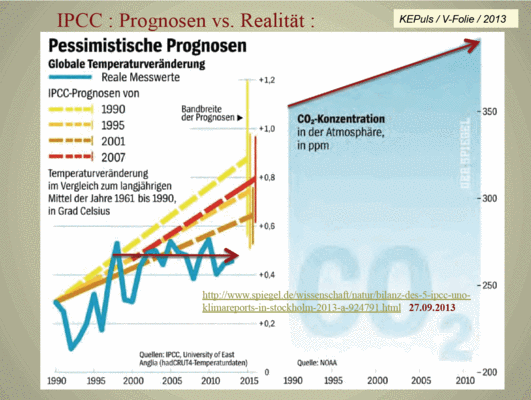
|
|
← 4 Prognosen von Professor Mojib Latif
1990 - 2009
-
2012-12-09 de
 Mojib Latif- Klimaprognosen 1990, 1997, 2006, 2008, 2009
Mojib Latif- Klimaprognosen 1990, 1997, 2006, 2008, 2009
Prof. Latif 1997
-
1997
de Mojib Latif 1997 - Neue Eiszeit
Mojib Latif 1997 - Neue Eiszeit
Im Jahre 1997 hat der Klimaforscher Mojib Latif in den Sendungen ZDF Hallo Deutschland und DAS! (NDR) Prognosen zu den Wintern der kommenden Jahre abgegeben.
Die Prognosen lauteten folgendermaßen:
"Gemittelt über die nächsten 20 Jahre gehen wir davon aus, dass es eher kälter sein wird."
"Diese Situation (die Nordatlantische Oszillation) hat sich jetzt umgestellt, so dass das Russlandhoch die Überhand über unser Klima gewinnen wird. So das wir davon ausgehen, dass wir innerhalb der nächsten 10 bis 20 Jahre eher mit kühleren Wintern zu rechnen haben."
"Die Nordatlantische Oszillation hat sich in den letzten Jahren umgestellt und wir sind jetzt in einer Phase relativ schwacher Nordatlantischer Oszillation und wir erwarten ähnlich wie in den 60er Jahren relativ kalte Winter in der Zukunft."
Zur globalen Erwärmung sagte er im Jahre 1997
"Daher haben wir es zunächst einmal vor allem mit den natürlichen Klimaschwankungen zu tun, während wir erst in etwa 100 Jahren dann die globale Erwärmung zu spüren bekommen."
-
Die kalte Sonne (Fritz Vahrenholt & Sebastian Lüning)
2013-11-11 de Mojib Latif 1997: "Gemittelt über die nächsten 20 Jahre gehen wir davon aus, dass es eher kälter sein wird"
-
Readers Edition
2010-04-02 de Mojib Latif 1997 - Neue Eiszeit
Mojib Latif 1997 - Neue Eiszeit
Prof. Latif 2000
-
"Winter mit starkem Frost und viel Schnee wie noch vor zwanzig Jahren wird es in unseren Breiten nicht mehr geben."
-
In Deutschland gehören klirrend kalte Winter der Vergangenheit an.
-
Spiegel Online 2004-04-01
de Winter ade - Nie wieder Schnee?
In Deutschland gehören klirrend kalte Winter der Vergangenheit an:
"Winter mit starkem Frost und viel Schnee wie noch vor zwanzig Jahren wird es in unseren Breiten nicht mehr geben",
sagt der Wissenschaftler Mojib Latif vom Hamburger Max-Planck-Institut für Meteorologie.
Prof. Latif 2003
-
In Deutschland wird es nach Ansicht des Kieler Klimaforschers Prof. Mojib Latif künftig immer häufiger trockene, heisse Sommer und eher milde und schneearme Winter geben.
Prof. Latif 2004
-
Der Kieler Klimaexperte Mojib Latif warnt vor einer drohenden, unkalkulierbaren Erwärmung der Erdatmosphäre: "Der Welt droht eine Heißzeit", sagte der renommierte Meteorologe dem Magazin Readers Digest.
-
Die globale Erderwärmung wird laut Latif "zu Dreiviertel von den Menschen und zu einem Viertel von natürlichen Einflüssen" verursacht.
-
UmweltDialog
2004-08-02 de Klimawandel löst Völkerwanderung aus
Prof. Latif 2008
-
Der Klimawandel könnte erst mal eine kleine Pause einlegen, schreiben der Kieler Forscher Mojib Latif und seine Kollegen im Wissenschaftsmagazin "Nature" (Bd. 453, Seite 84-88).
-
Klimamodelle, die auch Ozeanströmungen berücksichtigten, ergaben einen um etwa 0,2 Grad geringeren Temperaturanstieg als bei früheren, gröberen Simulationen
-
Einen äußeren Grund für das langfristig schwankende Klima, etwa die Sonne, gibt es laut Latif nicht: "Das Klima der Erde schwankt von sich aus, ohne dass man einen speziellen Antrieb dafür braucht."
Prof. Latif 2009
-
Die Erde kühlt sich seit knapp einem Jahrzehnt wieder deutlich ab.
-
Es würde auch in den nächsten Jahrzehnten kälter statt wärmer werden.
-
Mojib Latif
2009-12-02 de Apokalyptische Klimaprognosen: Wie Forscher Angst schüren
Apokalyptische Klimaprognosen: Wie Forscher Angst schüren
2009-03-13 de
 Mojib Latif: Klimaprognosen 2009, 1990, 2008, 1997, 2006
Mojib Latif: Klimaprognosen 2009, 1990, 2008, 1997, 2006
Prof. Latif 2010
-
"... wir müssen weiterhin mit kalten Wintern rechnen, denn der
Einfluss der globalen Erwärmung auf das Wettergeschehen ist zum Glück
noch relativ gering.
Sie werden allerdings immer seltener werden."
Kommentar von Andreas Kreuzmann (Klimaskeptiker.info):
-
"Man kann sich kaum ein durchsichtigeres Rückzugsmanöver vorstellen:
Die angeblich so zuverlässigen Klimamodelle vom letzten Jahr [2007] haben komplett versagt, die aktuellen Messdaten beweisen eine Abkühlung, jetzt hat das natürlich Herr Latif alles schon immer gewusst und berechnet!Und in zehn Jahren (wenn er so langsam in Rente geht - er ist Jahrgang 1954 - und seine Schäfchen im Trockenen hat) kommt dann ganz bestimmt die oft herbeigeredete, aber immer wieder ausgefallene 'Klimakatastrophe', diesmal dann aber wirklich, ganz ehrlich, Ehrenwort!"
Prof. Latif 2012
-
ARD-Morgenmagazin
2012-02-13 de Die kalte Sonne: Fritz Vahrenholt vs. Mojib Latif
Die kalte Sonne: Fritz Vahrenholt vs. Mojib Latif
Bei dem Klimaforscher Mojib Latif liegen augenscheinlich die Nerven blank, da er auf die Klimathesen von Vahrenholt keine wirklichen Antworten hat.
Seltsam ist auch: Die gleichen Thesen wie Vahrenholt hatte Latif selbst bereits im Dezember 2009 verbreitet, und nun kritisiert Latif diese Thesen an Fritz Vahrenholt.
-
Extremwetter-Kongress in Hamburg / Mojib Latif
2012-03-20/23 de Das Klima bis 2022
Das Klima bis 2022
Prof. Latif 2015
Man hat aus der Pleite gelernt
Nur noch 15 Jahre bleiben nach ihrer Ansicht, um den Klimawandel in den Griff zu bekommen. "Wenn der weltweite Kohlendioxidausstoß 2030 immer noch steigt, wird es zu spät sein", sagt der Klimaforscher Mojib Latif vom Kieler Helmholtz-Zentrum für Ozeanforschung.
Es ist das erste Mal, dass Latif sich öffentlich so konkret festlegt.
-
Die kalte Sonne (Fritz Vahrenholt & Sebastian Lüning)
2015-06-02 de IPCC im Jahr 2007: "Es bleiben vielleicht nur noch acht Jahre bis zur Klimakatastrophe"Im Jahr 2007 warnte der IPCC anlässlich der Herausgabe des 4. Klimazustandsberichts, dass die Zeit allmählich knapp werde, um die Klimakatastrophe noch zu vermeiden.
Man hätte vermutlich nur noch 8 Jahre, um der Apokalypse zu entkommen.
Man müsse umgehend handeln, sonst drohe die Hölle auf Erden.
Rechnen wir kurz nach:
2007 plus 8 ergibt 2015, unser heutiges Jahr. Von der Klimakatastrophe ist allerdings immer noch nichts zu sehen.
Die Temperatur liegt heute auf dem gleichen Niveau wie 2007 - und wie 1998.
Auch Wetterextreme haben nicht zugenommen.
Ganz offensichtlich hat man 2007 wohl etwas übertrieben.
Erinnern will sich daran heute niemand mehr.
Man blickt lieber in die Zukunft.
Was geht mich mein Geschätz von gestern an?Gelernt hat man aus der Pleite trotzdem: Mojib Latif
Kurzerhand verdoppelte Mojib Latif jetzt die Zeitspanne auf 15 Jahre und startet die Uhr 2015 einfach wieder neu bei Null.
Genial - Die Welt berichtete am 5. April 2015:
Es bleibt nicht mehr viel Zeit.
Das ist die Botschaft, die Klimaforscher den Politikern auf der ganzen Welt auf den Weg geben.
Nur noch 15 Jahre bleiben nach ihrer Ansicht, um den Klimawandel in den Griff zu bekommen. "Wenn der weltweite Kohlendioxidausstoß 2030 immer noch steigt, wird es zu spät sein", sagt der Klimaforscher Mojib Latif vom Kieler Helmholtz-Zentrum für Ozeanforschung.
Es ist das erste Mal, dass Latif sich öffentlich so konkret festlegt.
Im Jahr 2030 ist Latif dann in Rente und es kann ihm dann herzlich egal sein, ob er richtig oder falsch lag.
Ihm muss dabei bewusst sein, dass die Temperaturen auch in 15 Jahren noch auf dem heutigen Niveau liegen könnten, da die Ozeanzyklen bis dahin kühlend wirken werden.
Siehe "Judith Curry prognostiziert Erwärmungspause bis in die 2030er Jahre:
 Nordatlantik wird sich im kommenden Jahrzehnt leicht abkühlen
Nordatlantik wird sich im kommenden Jahrzehnt leicht abkühlen
Hans von Storch fordert in einem solchen Fall Misstrauensvotum gegen CO2".
▶Hans von Storch fordert in einem solchen Fall Misstrauensvotum gegen CO2
Quellen / Sources:
-
Die Welt
2015-04-05 de 2030 schließt sich das Zeitfenster der ErderwärmungNur noch 15 Jahre bleiben nach ihrer Ansicht, um den Klimawandel in den Griff zu bekommen.
Der Klimawandel ist noch abwendbar.
Das zumindest sagt der Klimawissenschaftler Mojib Latif.
Der sinkende Kohle-Verbrauch in China erscheint ihm als leiser Hoffnungsschimmer.
![]() USA: Kohle und Kohlekraftwerke
USA: Kohle und Kohlekraftwerke
![]() de
Die Vereinigten Staaten sind das "Saudi Arabien" der Kohle
de
Die Vereinigten Staaten sind das "Saudi Arabien" der Kohle
en
America is the "Saudi Arabia" of Coal
fr
Les Étas Unis sont "l'Arabie Saoudite" du charbon
-
The Guardian
2007-05-02 en UN scientists warn time is running out to tackle global warmingGovernments are running out of time to address climate change and to avoid the worst effects of rising temperatures, an influential UN panel warned yesterday.
Greater energy efficiency, renewable electricity sources and new technology to dump carbon dioxide underground can all help to reduce greenhouse gas emissions, the experts said.
But there could be as little as eight years left to avoid a dangerous global average rise of 2C or more.
| Mojib Latif |
Dr. rer. nat.,
Professor für Meteorologie am Leibniz-Institut für
Meereswissenschaften (IFM-GEOMAR) an der Universität Kiel.
▶Mojib Latif: Who is who (Aktivisten der anthropogenen Erwärmung) |
← 5 Prognosen von UK Met Office
de
Flop des UK Met Office 2007: "Bis 2014 wird es um 0,3°C
wärmer"
en Smith et al (2007): 0.3°C in 10 years
-
Die kalte Sonne (Fritz Vahrenholt & Sebastian Lüning)
Paul Matthews
2013-12-04 de Vorhersage-Flop des UK Met Office 2007: "Bis 2014 wird es um 0,3°C wärmer"In der Studie von Smith et al. wurden folgende Vorhersagen aufgestellt:
In der Dekade 2004 bis 2014 würde es zu einer Erwärmung um 0,3°C kommen.
Mindestens die Hälfte der Jahre nach 2009 würde wärmer ausfallen als das Rekordjahr 1998
Die Vorhersagen haben sich jetzt jedoch als falsch herausgestellt.
Wir sind fast schon im Jahr 2014 angekommen, und seit dem Jahr 2004 hat es keinerlei Erwärmung gegeben.
Von den Jahren seit 2009 hat kein einziges den Rekord des Jahres 1998 gebrochen, jedenfalls den HadCRUT3-Daten zufolge.
Quellen / Sources:
-
EIKE Europäisches Institut für Klima und Energie
2013-11-30 de Die gekonnten Vorhersagen der Klimawissenschaft
-
The IPCC Report - Looking into the 5th IPCC Report
2013-11-20 en The skillful predictions of climate scienceThe Smith et al paper made the following specific predictions:
There would be 0.3°C warming over the decade 2004-2014
At least half of the years after 2009 would be warmer than the record year of 1998.
These predictions have turned out to be wrong.
We are almost into 2014 and there has been no warming at all since 2004.
Of the years since 2009, none of them have broken the record of 1998 according to HADCRUT3 data.
en Met Office Global Forecasts Too Warm In 13 Of Last 14 Years
-
Watts Up With That? (Antony Watts)
2014-01-29 en BBC Meteorologist: Met Office Global Forecasts Too Warm In 13 Of Last 14 Years
| de | en | fr |
|---|---|---|
|
Neue Kälteperiode Meldungen |
New Cold Period News |
Nouvelle periode froide Actualités |
← 6 15 Years Since The UN Declared The North Pole To Be Ice-Free
Quellen / Sources:
-
Real Science (Toni Heller, alias Steven Goddard)
2015-01-02 en 15 Years Since The UN Declared The North Pole To Be Ice-Free
-
The New York Time
2000-08-19 en Ages-Old Icecap at North Pole Is Now Liquid, Scientists Find
← 7 Gore: Polar ice cap may disappear by summer 2014
-
Kopp Online
2013-12-21 en Al Gore sagte voraus, 2013 sei die Arktis völlig eisfrei - stattdessen ist die Eisschicht um die Hälfte gewachsen
-
USA Today
2009-12-14 en Gore: Polar ice cap may disappear by summer 2014
-
 2009-12-16 en
Al Gore Warns Polar Ice May Be Gone in Five Years
2009-12-16 en
Al Gore Warns Polar Ice May Be Gone in Five Years
Former Vice President Al Gore references computer modeling to suggest that the north polar ice cap may lose virtually all of its ice within the next seven years. "Some of the models suggest that there is a 75 percent chance that the entire north polar ice cap, during some of the summer months, could be completely ice-free within the next five to seven years," says Gore.
-
 2013-09-15 en
Wrong: Al Gore Predicted Arctic Summer Ice Could Disappear In 2013
2013-09-15 en
Wrong: Al Gore Predicted Arctic Summer Ice Could Disappear In 2013
A 2007 prediction that summer in the North Pole could be "ice-free by 2013" that was cited by former Vice President Al Gore in his Nobel Peace Prize acceptance speech has proven to be off by 920,000 square miles.
In his Dec. 10, 2007 "Earth has a fever" speech, Gore referred to a prediction by U.S. climate scientist Wieslaw Maslowski that the Arctic?s summer ice could "completely disappear" by 2013 due to global warming caused by carbon emissions.
Gore said that on Sept. 21, 2007, "scientists reported with unprecedented alarm that the North Polar icecap is, in their words, 'falling off a cliff.' One study estimated that it could be completely gone during summer in less than 22 years. Another new study to be presented by U.S. Navy researchers later this week warns that it could happen in as little as seven years, seven years from now."
Maslowski told members of the American Geophysical Union in 2007 that the Arctic's summer ice could completely disappear within the decade. "If anything," he said, ?our projection of 2013 for the removal of ice in summer is already too conservative.
The former vice president also warned that rising temperatures were "a planetary emergency and a threat to the survival of our civilization."
← 8 John Holdren - Obamas Wissenschaftsberater
|
Eine Milliarde CO2-Todesfälle durch Hungersnot bevor 2020 Mehrere prominente Wissenschaftler, haben für die letzten 4 Jahrzehnte eine Katastrophe vorausgesagt, wenn wir fossile Brennstoffe weiterhin nutzen. Im Jahr 1985 sagte Obamas Wissenschaftsberater John Holdren voraus, dass wir jetzt, nahe an einer Milliarde CO2-Todesfälle durch Hungersnot seien, bevor wir 2020 erreichen. |
← 9 Weitere Prognosen
Top 10 FAILED Global Warming Predictions
-
2012-06-16 en
 Top 10 FAILED Global Warming Predictions
Top 10 FAILED Global Warming Predictions
ABC News: 2008 prediction about climate in 2015 .. what a gaffe!
-
2015-06-23 en
 2008 prediction about climate in 2015 .. what a gaffe!
2008 prediction about climate in 2015 .. what a gaffe!
New York City underwater?
Gas over $9 a gallon?
A carton of milk costs almost $13?
Welcome to June 12, 2015.
Or at least that was the wildly-inaccurate version of 2015 predicted by ABC News exactly seven years ago.
Appearing on Good Morning America in 2008, Bob Woodruff hyped Earth 2100, a special that pushed apocalyptic predictions of the then-futuristic 2015.The segment included supposedly prophetic videos, such as a teenager declaring,
"It's June 8th, 2015. One carton of milk is $12.99." (On the actual June 8, 2015, a gallon of milk cost, on average, $3.39.)
Another clip featured this prediction for the current year: "Gas reached over $9 a gallon." (In reality, gas costs an average of $2.75.)
de Im Jahr 2008 strahlte der US-amerikanische Sender abcnews eine Sendung zur Klimagefahr aus.
Die wichtigste Nachricht: Schon sieben Jahre später, 2015, würde das Klima verrückt spielen und sich die Klimakatastrophen häufen.
Alles falsch, wie wir heute wissen.
Ungeachtet dieses Fehlschlags werden auch auch heute noch ähnliche Filme produziert.
Wenn dann das Prognosejahr erreicht ist, wird sich eh niemand mehr an die verrückten Schauergeschichten erinnern.
Nine Years Since The New York Times Announced The End Of Winter
-
Real Science (Toni Heller, alias Steven Goddard)
2015-10-01 en Nine Years Since The New York Times Announced The End Of WinterIn 2006, the New York times announced the end of winter and said that winter temperatures in the Northeast had increased 4.3 degrees.
Pentagon Says Europe Will Drown In The Next Four Years
-
Real Science (Steven Goddard)
2015-09-27 en Pentagon Says Europe Will Drown In The Next Four YearsWe give the Pentagon hundreds of billions of dollars a year, but they didn't have enough money to find out that sea level isn't actually rising in much of Europe.
↑
F Keine wissenschaftlich fundierten Vorhersagen der Globalen Erwärmung
en No Scientific Forecasts to Support Global Warming
fr Pas de prognostiques scientifiques pour le réchauffement climatique
- 1 de Zweifelhafte wissenschaftliche Methoden bei Klima-Voraussagen
- 2 en No Scientific Forecasts to Support Global Warming
↑ 1 de Zweifelhafte wissenschaftliche Methoden bei Klima-Voraussagen
-
Führende Experten für wissenschaftliche Prognostik stellen fest: IPCC Prognosen verletzen so gut wie alle wissenschaftlichen Prognosestandards.
Die Drs. Scott Armstrong und Dr.Kesten Green haben eine Arbeit veröffentlicht, in welcher sie die führenden Klima-Alarmisten beschuldigen, bei der Klima-Voraussage wichtige wissenschaftliche Methoden zu ignorieren:
Basierend auf ihrer 2007 veröffentlichten Analyse der IPCC-Methodik zur Klimavorhersage stellen die Autoren in einem Gutachten für den US Senat fest:
"Die einzigen Vorhersagen über die künftige Klima-Entwicklung basieren auf der Meinung einiger Wissenschaftler.
Computer wurden benutzt, um Szenarien zu erzeugen (d.h. Stories oder Annahmen), die widerspiegeln, was die Wissenschaftler sich vorstellten.
Diese Szenarien waren nicht als Voraussagen gedacht (Trenberth, 2007) und sie wurden auch nicht entsprechend verifiziert.
Seit Veröffentlichung unseres Aufsatzes im Jahre 2007 hat niemand unserer Behauptung widersprochen, dass es bisher keine wissenschaftlich fundierten Voraussagen zur globalen Erwärmung gegeben hat.
Wir führten eine Prüfung der Methoden durch, die im IPCC-Bericht angewandt wurden und fanden heraus, dass nicht weniger als 72 Prinzipien und Methoden für Vorhersagen missachtet wurden, und das ohne Begründung.
Bei wichtigen Vorhersagen können wir keinen Grund sehen, warum diese Prinzipien verletzt werden.
Mit der Analogie zum Fliegen eines Flugzeuges, dem Bau einer Brücke oder der Durchführung einer Herztransplantation sind die potentiellen Kosten eines Fehlers so hoch, dass es nicht erlaubt ist, wichtige Prinzipien zu verletzen.
Soweit wir wissen, wurden auch Veröffentlichungen, die sich mit der Vorhersage globaler Erwärmung befassten, nicht der üblichen Überprüfung durch Experten bezüglich der angewandten Methoden und Prinzipien unterworfen.
Die Komplexität und Unsicherheit von Klimadaten machen die Meinung von Experten alleine unbrauchbar für wissenschaftlich fundierte Voraussagen."
-
EIKE Europäisches Institut für Klima und Energie
2009-02-09 de Expertenschreiben an US Senat: Zweifelhafte wissenschaftliche Methoden bei Klima-Voraussagen.
↑ 2 en No Scientific Forecasts to Support Global Warming
Drs. J. Scott Armstrong and Kesten C. Green were asked by US Senator Inhofe for an analysis of the EPA's proposed policies for greenhouse gases
EPA = U.S. Environmental Protection Agency
-
No scientific forecasts of the changes in the Earth's climate.
Currently, the only forecasts are those based on the opinions of some scientists. Computer modeling was used to create scenarios (i.e., stories) to represent the scientists' opinions about what might happen.
The models were not intended as forecasting models (Trenberth 2007) and they have not been validated for that purpose.
Since the publication of our paper, no one has provided evidence to refute our claim that there are no scientific forecasts to support global warming.
We conducted an audit of the procedures described in the IPCC report and found that they clearly violated 72 scientific principles of forecasting (Green and Armstrong 2008). (No justification was provided for any of these violations.)
For important forecasts, we can see no reason why any principle should be violated. We draw analogies to flying an aircraft or building a bridge or performing heart surgery-given the potential cost of errors, it is not permissible to violate principles.
-
Improper peer review process.
To our knowledge, papers claiming to forecast global warming have not been subject to peer review by experts in scientific forecasting.
-
Complexity and uncertainty of climate render expert opinions invalid for forecasting.
Expert opinions are an inappropriate forecasting method in situations that involve high complexity and high uncertainty.
This conclusion is based on over eight decades of research.
Armstrong (1978) provided a review of the evidence and this was supported by Tetlock's (2005) study that involved 82,361 forecasts by 284 experts over two decades.
Long-term climate changes are highly complex due to the many factors that affect climate and to their interactions.
Uncertainty about long-term climate changes is high due to a lack of good knowledge about such things as:
- causes of climate change,
- direction, lag time, and effect size of causal factors related to climate change,
- effects of changing temperatures, and
- costs and benefits of alternative actions to deal with climate changes (e.g., CO2 markets).
Given these conditions, expert opinions are not appropriate for long-term climate predictions.
-
Forecasts are needed for the effects of climate change.
Even if it were possible to forecast climate changes, it would still be necessary to forecast the effects of climate changes.
In other words, in what ways might the effects be beneficial or harmful?
Here again, we have been unable to find any scientific forecasts-as opposed to speculation-despite our appeals for such studies.
We addressed this issue with respect to studies involving the possible classification of polar bears as threatened or endangered (Armstrong, Green, and Soon 2008).
In our audits of two key papers to support the polar bear listing, 41 principles were clearly violated by the authors of one paper and 61 by the authors of the other.
It is not proper from a scientific or from a practical viewpoint to violate any principles.
Again, there was no sign that the forecasters realized that they were making mistakes.
-
Forecasts are needed of the costs and benefits of alternative actions that might be taken to combat climate change.
Assuming that climate change could be accurately forecast, it would be necessary to forecast the costs and benefits of actions taken to reduce harmful effects, and to compare the net benefit with other feasible policies including taking no action.
Here again we have been unable to find any scientific forecasts despite our appeals for such studies.
-
To justify using a climate forecasting model, one would need to test it against a relevant naïve model.
We used the Forecasting Method Selection Tree to help determine which method is most appropriate for forecasting long-term climate change. A copy of the Tree is attached as Appendix 1.
It is drawn from comparative empirical studies from all areas of forecasting.
It suggests that extrapolation is appropriate, and we chose a naïve (no change) model as an appropriate benchmark.
A forecasting model should not be used unless it can be shown to provide forecasts that are more accurate than those from this naïve model, as it would otherwise increase error.
In Green, Armstrong and Soon (2008), we show that the mean absolute error of 108 naïve forecasts for 50 years in the future was 0.24°C.
-
The climate system is stable.
To assess stability, we examined the errors from naïve forecasts for up to 100 years into the future.
Using the U.K. Met Office Hadley Centre's data, we started with 1850 and used that year's average temperature as our forecast for the next 100 years.
We then calculated the errors for each forecast horizon from 1 to 100.
We repeated the process using the average temperature in 1851 as our naïve forecast for the next 100 years, and so on.
This "successive updating" continued until year 2006, when we forecasted a single year ahead.
This provided 157 one-year-ahead forecasts, 156 two-year-ahead and so on to 58 100-year-ahead forecasts.
We then examined how many forecasts were further than 0.5°C from the observed value.
Fewer than 13% of forecasts of up to 65-years-ahead had absolute errors larger than 0.5°C.
For longer horizons, fewer than 33% had absolute errors larger than 0.5°C.
Given the remarkable stability of global mean temperature, it is unlikely that there would be any practical benefits from a forecasting method that provided more accurate forecasts.
-
Be conservative and avoid the precautionary principle.
One of the primary scientific principles in forecasting is to be conservative in the darkness of uncertainty. This principle also argues for the use of the naive no-change extrapolation. Some have argued for the precautionary principle as a way to be conservative. It is a political, not a scientific principle.
As we explain in our essay in Appendix 2, it is actually an anti-scientific principle in that it attempts to make decisions without using rational analyses. Instead, cost/benefit analyses are appropriate given the available evidence which suggests that temperature is just as likely to go up as down.
However, these analyses should be supported by scientific forecasts.
The reach of these models is extraordinary, for example, the CSIRO models are currently being used in Australia to determine water allocations for farmers and to justify the need for an Emissions Trading Scheme (ETS) - the most far-reaching of possible economic interventions.
Yet, according to Dr Armstrong, these same models violate 72 scientific principles.
-
Watts Up With That? (Antony Watts)
2009-01-28 en Forecasting Guru Announces: "no scientific basis for forecasting climate"
-
Jennifer Marohasy
2009-01-28 en No Scientific Forecasts to Support Global Warming
-
Drs. J. Scott Armstrong and Kesten C. Green
2008-11-20, updated 2009-01-26 en Statement
Statement
-
Kesten C. Green and J. Scott Armstrong
Energy & Environment Volume 18 No. 7+8 2007:
 Global Warming: Forecasts by scientists versus scientific forcasts
Global Warming: Forecasts by scientists versus scientific forcasts
